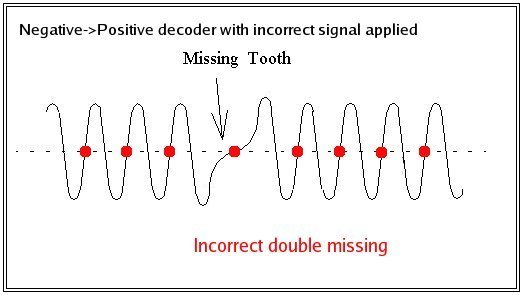Time for a bit of an update on this. Unfortunately, I am
still chasing a clean, reliable rpm input to the ECU. I have given up on trying
to take the input from the coil packs, simply because I would like to have the
Microsquirt control ignition timing as well as fuel at some point so there is
no point going through the pain twice.
I have made some bit of progress though. First is the
trigger wheel definition. I made the fundamental mistake of not physically
looking at the wheel myself and relying on pictures from the manual. Of course
I didn’t realise that I was looking at pictures of a trigger wheel on an mc17
CBR250 which has the 8-1 trigger wheel. It was only after one of the members on
the cbr250.com forum questioned me on this that I realised that the mc22
trigger wheel was a 12-3 definition. That explained some of the erratic signals
and why the rpm was jumping to over 21,000rpm at idle. The ECU was expecting
teeth where there was none and gaps where there were teeth.
The problem is that this didn’t fix the issue… It did make
it better as in the signal peaks read by the ECU were consistent with the
actual running rpm of the engine but the signal was still constantly dropping
to zero. I tried a few combinations of noise filters within the Microsquirt
software but to no avail. After contacting DIYAutotune who I bought the
Microsquirt from, they have advised that I try switching to MSII/Extra firmware
as it includes some extra diagnostics tools to help isolate the issue. One of
these is the trigger tooth logger. I should be able to use this function to see
if the ECU is actually reading each trigger tooth correctly and thereby tell me
whether I need to concentrate on the VR signal coming into the ECU, or the
settings within the ECU.
I have an idea that if the signal entering the ECU is the
issue then I will attempt to convert the VR signal to a Hall signal externally
using an LM1815 chip and feed that into the ECU. The ECU should be able to read
the square wave Hall signal much more easily and cleanly than the AC VR signal.
Also, I have decided to go ahead and modify the GSR400
throttle bodies right away rather than attempt to tune the system on modified
carburettors and then do it all again with throttle bodies. I am currently
preparing the drawings for the throttle bodies, butterfly valve rods, fuel rail
and fuel rail mount adapters so that I can get quotes from a few machine shops
and get it kicked off. Once the throttle bodies are ready, that will be a major
part of the project complete.




















